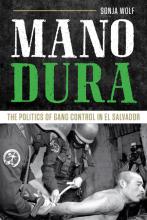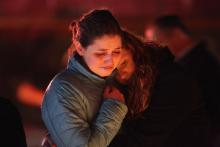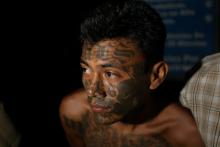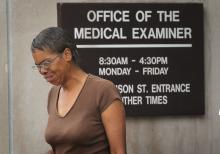Gangs

THE MERE MENTION of maras—gangs that formed in the U.S. and then spread throughout Central America—conjures up overcrowded prisons filled with ominous-looking, elaborately tattooed Central American youth flashing gang signs. While this reality does exist, it’s part of what German scholar Sonja Wolf calls a folkloric attempt to demonize disenfranchised sectors of society rather than invest in comprehensive social programs.
Her new academic book, Mano Dura: The Politics of Gang Control in El Salvador, offers a far deeper analysis of public policy. It’s a must-read for any aid worker or missionary hoping to build peace and prosperity in a country with one of the highest homicide rates in the world—81 homicides per 100,000 people, eight times the U.N.’s marker for an epidemic. It also raises important questions about how much violence can actually be attributed to gangs when crime data is patchy and politicized.
The book, an updated version of Wolf’s 2008 doctoral dissertation in international politics, examines two decades of attempts to “pacify” El Salvador’s gangs, a subculture that diversified and expanded after El Salvador’s 1992 U.N.-sponsored peace accords. During the 12 years prior, a civil war claimed some 75,000 lives and prompted 1 million Salvadorans to seek refuge in the U.S. Some of these young refugees joined large U.S. gangs such as 18th Street or created their own, such as MS-13, then brought their gang affiliation back to El Salvador during mass deportations in the early 1990s.

Bio: Tyrone Parker is the executive director of Alliance of Concerned Men (ACM), a nonprofit that works with youth living in high-crime areas in Washington, D.C.
1. What event or episode in your life has most informed your passion for working with urban youth and families?
One was the loss of my son, Rodney [who was killed in 1989]. The other was the record number of homicides within the District of Columbia. The District was once considered the “murder capital” of the United States.
When we first got started with the intervention program, it was due to a 12-year-old kid who was shot in the nation’s capital on the day of the Clinton inauguration. If you would’ve gone 10 minutes on East Capitol Street, you would’ve seen the inauguration with a major celebration. And 10 minutes down the same street, you had a whole community under house arrest. After that, we came together as a group to form the Alliance of Concerned Men.
2. What sorts of services and programs does ACM provide?
We teach a number of skills to at-risk youth, including gang intervention/prevention and mediation, workforce development, life skills training, leadership development, coaching for re-entry, and youth gang conflict resolution.
AS I ATTENDED seminary in my native Chicago, I heard about one senseless death after another. A six-month-old baby shot multiple times with an assault weapon; a young black girl, with promise and a future, caught in the crossfire—all casualties of gang violence.
This violence is further evidence to me that our theology is needed on the streets. A theology that can impact the crisis facing the black community must be relevant to the black community. Theology can never be disengaged from the history of black people, the “isms” that have oppressed us, and the struggles that have birthed our progress. “Relevancy,” for theology, means moving beyond the academy and the church and into the streets, where it becomes our thinking faith in action.
Does our theology have anything to say to African-American gang girls? The formation of girl gangs is rooted in the numerous social ills affecting many urban African-American communities. By taking our theology to the streets, we can offer African-American gang girls an alternative hope and future. Four theological frameworks can aid in that task.
First, a practical theology—thinking faith in action—that models Jesus’ ministry to the marginalized can reach these girls with the message of God’s compassion, peace, and hope by offering a positive relational sisterhood that can replace gang life.

Over the last few years we have heard much about the school to prison pipeline. According to the ACLU, it is:
a disturbing national trend wherein children are funneled out of public schools and into the juvenile and criminal justice systems. Many of these children have learning disabilities or histories of poverty, abuse or neglect, and would benefit from additional educational and counseling services. Instead, they are isolated, punished and pushed out.
The Children’s Defense Fund argues that because of a lack of early childhood education and healthy beginnings, this epidemic begins before a child is old enough to enroll in school, defining the problem as the Cradle to Prison pipeline. Organizations such as the Advancement Project, the Legal Defense Fund, and many others too have defined the school-to-prison pipeline as just another level to the mass incarceration epidemic and one of the most disturbing injustices we face today.
We know that the pipeline is undergirded by Zero Tolerance policies, mass expulsions, unprecedented school arrests, inadequate school funding, and myriad other unjust policies that either criminalize our children or rob them of the resources they need to be successful. We also know that high-school dropout is certainly a station on the pipeline. In many urban centers the dropout rate hovers around 50 percent, and some data suggests 7,000 students drop out of school every day. What happens to kids that drop out of school? Where do kids who are expelled end up?

My city of Chicago, known as the City with Big Shoulders, is now on its knees. But it’s not prostrate in some humble submission to God. No. Instead Chicago is weeping from the emotional exhaustion of having to bury too many youth who have been murdered.
Last year Chicago recorded 2,400 shootings and more than 505 murders, of which more than 108 were teenagers of color from seven violent communities. Already 2013, with less than two months into its birth, has seen 49 murders. Those of us on the ground seeking to bring change to this pandemic of violence know that if the Chicago cold winters are this violent, then the hot summers will not cool off. On top of the hard and constant news about those who are killing and being killed, Chicago Police stats show that only 34 percent of the murders get solved within one year. If the detectives have two years on a case, then the rate barely reaches 50 percent. The national average of murders solved is 64 percent. New York’s rate is only 60 percent. In Chicago, though, one has a 50-50 chance of getting away with a murder.
ON A BLAZING August day last summer, Rosa Pérez Triana faced a crowd of several hundred people in downtown Tucson and held up a color photo of a pretty young woman.
“This is my daughter, Coral,” Pérez said in Spanish, her voice breaking. “A year ago she went missing. There are thousands of people in Mexico like me who don’t know what happened to their loved ones.”
A middle-aged woman from the violent state of Nuevo León in northern Mexico, Pérez had come to the United States with the Caravan for Peace with Justice and Dignity to tell her North American neighbors what had happened to her daughter—and to an estimated 80,000 other Mexicans who have been killed or disappeared during the country’s six-year-old war on drugs.
Her daughter’s story is typical. Guadalupe Coral Pérez Triana vanished on July 24, 2011, somewhere on the road between Reynosa, Tamaulipas, and Monterrey, Nuevo León. Five other young women were traveling with her. All are missing and presumed dead.
“The main purpose of the caravan is to show a human face,” explained Laura Carlsen, director of the Center for International Policy’s Americas Program in Mexico, who joined the caravan on its last leg through the East Coast. “These are people whose family members were victims.” Such are the human costs of the war on drugs that the U.S. government supports with arms and money.

O Flower of Jesse’s stem,
you have been raised up as a sign for all peoples;
kings stand silent in your presence;
the nations bow down in worship before you.
Come, let nothing keep you from coming to our aid.
In 2012 more than one hundred young people were killed by gun violence in Chicago. More than a hundred. If you start adding up the numbers, there was a time there in the summer where Chicago was more dangerous than Afghanistan. Well, parts of it were. It's a big place, you know.
As tragic as the shooting was in Connecticut —and I am truly not interested in minimizing the grief or outrage — we have to wake up and realize that more children are killed every year in the U.S. and we seldom cry in outrage. Not as a nation. There were marches in protest by Chicago churches.
The news media covered the march but not the murders.

IN THE TRAGIC, often-hopeless world of gang violence, this year’s truce between two notorious gangs in El Salvador offers reasons for hope and a breakthrough opportunity for change.
Beginning in March, leaders of the infamous gangs Mara Salvatrucha (MS-13) and Barrio 18 called a truce from behind prison walls. The agreement was mediated by Monsignor Fabio Colindres, the Catholic chaplain for the Salvadoran police and military, and Raúl Mijango, a former legislator and, before that, military commander in the FMLN, the onetime guerrilla movement that is now the country’s elected ruling party.
The truce, which was still in effect at press time, immediately reduced violence in El Salvador, which has been among the world’s most deadly countries in recent years. Since early April, said President Mauricio Funes in late August, the murder rate has gone down to around five per day, a decrease of more than 60 percent from the 13.5 per day average of January and February.
The gang violence that has plagued El Salvador and other Central American countries in recent years is an import, brought by youth deported from the United States. MS-13 and Barrio 18 both originated on the streets of Los Angeles—ironically, built by young people whose families were refugees fleeing the U.S.-backed violence of Central American civil wars and death squads in the 1980s.
But just as violence can be moved across national borders, peace can be as well.
ON A FLIGHT from New York City to Guatemala some years back, I met a woman from Oklahoma on her way to visit her soon-to-be internationally adopted daughter. “I just found them, the Guatemalan children, on the internet and thought they were so beautiful,” she said. She beamed, her blue eyes, carefully painted lips, and cross earrings all sparkling.
Guatemala’s landscape, where wistful clouds cruise above fertile fields and past rumbling volcanoes, reflects the volatility of the country’s tragic history. That history includes a decades-long civil war, ending in 1996, in which more than 200,000 people were killed, mainly by U.S.-backed government forces. To visit the country is to experience not just that history, but also a culture that pioneered astronomy, devised an intricate written language, and erected engineering miracles. But, asked whether she intended to preserve her adoptive daughter’s ties to her homeland, the woman I met on the plane said, “If she wants to see it, we’ll bring her. But really, there’s nothing there.”
The attitude that “there’s nothing there” is, all too frequently, the attitude of missionaries en route to Guatemala. But when Joel Van Dyke arrived in 2003 from Philadelphia, he suspected there was plenty there—there in the country’s slums and in the cities’ bursting garbage dumps, where thousands of people find sustenance every day. He set out to find what was there by learning to ask the right questions of gang members, slum dwellers, sex workers, and the local faith leaders who work with them. To do this, he told Sojourners, he had to adopt the attitude “let’s go see what God is doing in the world and let that color and shape the theological discourse.”

Editor's Note: This piece is part of a longer series on the wave of violence hitting Chicago, with murders for the year reaching the 250 mark this week. Some think the solution is purely over-policing or sending in the National Guard. Mayor Rahm Emanuel may legalize small amounts of marijuana so police can focus on violent crime. We asked some contributors—people who are on the ground in Chicago working for change—to discuss real, creative solutions.
For all its deep dish pizzas and –style hot dogs, The Crib is one of the most violent cities in the world.
When I say in the world, I mean that 1,976 Americans have died in Afghanistan since 2001, and there have been 5,056 murders in Chicago during the same period. (A specious stat for a number of reasons, but let’s move toward the point people are getting at when they mention this). This is a dangerous town. “How do we stop it?” is the million dollar question, and will net someone a Nobel Peace Prize if they can figure it out.
Robert Brenneman’s article (“The Cross and the Crossfire,” April 2009) leaves this reader incredulous.

In Central America, Christians are countering gang and government violence armed only with faith and the belief that no one -- not even the worst criminal -- is beyond hope.
